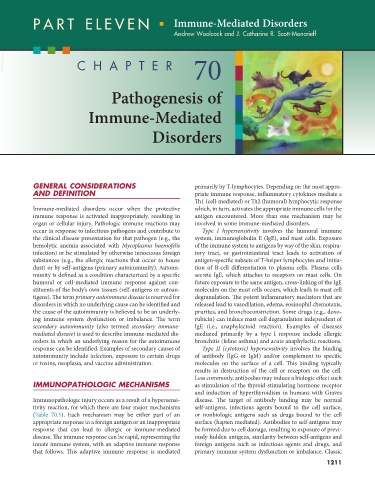Page 1239 - Small Animal Internal Medicine, 6th Edition
P. 1239
PART ELEVEN Immune-Mediated Disorders
Andrew Woolcock and J. Catharine R. Scott-Moncrieff
VetBooks.ir CHAPTER 70
Pathogenesis of
Immune-Mediated
Disorders
GENERAL CONSIDERATIONS primarily by T-lymphocytes. Depending on the most appro-
AND DEFINITION priate immune response, inflammatory cytokines mediate a
Th1 (cell-mediated) or Th2 (humoral) lymphocytic response
Immune-mediated disorders occur when the protective which, in turn, activates the appropriate immune cells for the
immune response is activated inappropriately, resulting in antigen encountered. More than one mechanism may be
organ or cellular injury. Pathologic immune reactions may involved in some immune-mediated disorders.
occur in response to infectious pathogens and contribute to Type I hypersensitivity involves the humoral immune
the clinical disease presentation for that pathogen (e.g., the system, immunoglobulin E (IgE), and mast cells. Exposure
hemolytic anemia associated with Mycoplasma haemofelis of the immune system to antigens by way of the skin, respira-
infection) or be stimulated by otherwise innocuous foreign tory tract, or gastrointestinal tract leads to activation of
substances (e.g., the allergic reactions that occur to house antigen-specific subsets of T-helper lymphocytes and initia-
dust) or by self-antigens (primary autoimmunity). Autoim- tion of B-cell differentiation to plasma cells. Plasma cells
munity is defined as a condition characterized by a specific secrete IgE, which attaches to receptors on mast cells. On
humoral or cell-mediated immune response against con- future exposure to the same antigen, cross-linking of the IgE
stituents of the body’s own tissues (self-antigens or autoan- molecules on the mast cells occurs, which leads to mast cell
tigens). The term primary autoimmune disease is reserved for degranulation. The potent inflammatory mediators that are
disorders in which no underlying cause can be identified and released lead to vasodilation, edema, eosinophil chemotaxis,
the cause of the autoimmunity is believed to be an underly- pruritus, and bronchoconstriction. Some drugs (e.g., doxo-
ing immune system dysfunction or imbalance. The term rubicin) can induce mast cell degranulation independent of
secondary autoimmunity (also termed secondary immune- IgE (i.e., anaphylactoid reaction). Examples of diseases
mediated disease) is used to describe immune-mediated dis- mediated primarily by a type I response include allergic
orders in which an underlying reason for the autoimmune bronchitis (feline asthma) and acute anaphylactic reactions.
response can be identified. Examples of secondary causes of Type II (cytotoxic) hypersensitivity involves the binding
autoimmunity include infection, exposure to certain drugs of antibody (IgG or IgM) and/or complement to specific
or toxins, neoplasia, and vaccine administration. molecules on the surface of a cell. This binding typically
results in destruction of the cell or receptors on the cell.
Less commonly, antibodies may induce a biologic effect such
IMMUNOPATHOLOGIC MECHANISMS as stimulation of the thyroid-stimulating hormone receptor
and induction of hyperthyroidism in humans with Graves
Immunopathologic injury occurs as a result of a hypersensi- disease. The target of antibody binding may be normal
tivity reaction, for which there are four major mechanisms self-antigens, infectious agents bound to the cell surface,
(Table 70.1). Each mechanism may be either part of an or nonbiologic antigens such as drugs bound to the cell
appropriate response to a foreign antigen or an inappropriate surface (hapten mediated). Antibodies to self-antigens may
response that can lead to allergic or immune-mediated be formed due to cell damage, resulting in exposure of previ-
disease. The immune response can be rapid, representing the ously hidden antigens, similarity between self-antigens and
innate immune system, with an adaptive immune response foreign antigens such as infectious agents and drugs, and
that follows. This adaptive immune response is mediated primary immune system dysfunction or imbalance. Classic
1211

